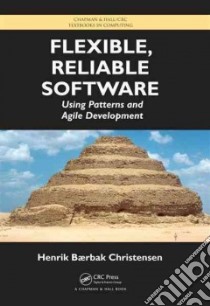- Libreria
- >
- Libri in lingua
- >
Flexible, Reliable Software - 9781420093629
Un libro in lingua di Christensen Henrik Baerbak edito da Chapman & Hall, 2010
- € 94.60
- Il prezzo è variabile in funzione del cambio della valuta d’origine
"...This book brings together a careful selection of topics that are relevant, indeed crucial, for developing good quality software with a carefully designed pedagogy that leads the reader through an experience of active learning..."
ùFrom the Foreword by Michael K÷lling, originator of the BlueJ and Greenfoot environments, co-author of the best-selling Objects First with Java, and author of the best-selling Introduction to Programming with Greenfoot
Flexible, Reliable Software: Using Patterns and Agile Development guides readers through the software development process. By describing practical stories, explaining the design and programming process in detail, and using projects as a learning context, the text helps readers understand why a given technique is required and why techniques must be combined to overcome the challenges facing software developers.
The presentation is organized as a realistic development story in which customer requests require introducing new techniques to combat ever-increasing software complexity. The book presents the core practices, concepts, tools, and analytic skills for designing flexible and reliable software, including test-driven development, refactoring, design patterns, test doubles, and responsibility-driven and compositional design. It then provides a collection of design patterns leading to a thorough discussion of frameworks. The author also discusses the important topics of configuration management and systematic testing. In the last chapter, projects lead readers to design and implement their own frameworks, resulting in a reliable and usable implementation of a large and complex software system complete with a graphical user interface.
Features
Shows how to use agile testing and patterns for software design
Discusses the benefits and liabilities of each approach
Presents fifteen design patterns as well as the principles behind them
Includes review questions, exercises, and selected solutions as well as projects that represent real-world tasks
Provides source code and other resources on www.baerbak.com
Informazioni bibliografiche
- Titolo del Libro in lingua: Flexible, Reliable Software
- Sottotitolo: Using Patterns and Agile Development
- Lingua: English
- Autore: Christensen Henrik Baerbak
- Editore: Chapman & Hall
- Collana: Chapman & Hall (Hardcover)
- Data di Pubblicazione: 03 Maggio '10
- Genere: COMPUTERS
- Argomenti : Computer software Reliability Computer software Development
- ISBN-10: 1420093622
- EAN-13: 9781420093629


